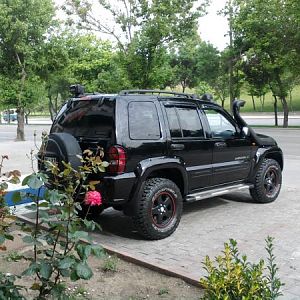Few suggestions for you guys with winches.
- Snatch Block: Most people don't know but a winch rating is for only the first wrap around the drum. If you have an 8k lb rated winch with a 100' cable and you're pulling yourself out using an anchor 25' away you may have 4 wrapped layers on the drum still. Each wrap will eat ~15-20% of the rated pull strength. In this scenario you're left with 5k-5.2k lb rating.
Now if you're in sunk in or on an incline you can expect for your load on the winch to increase. If you're stuck axle deep the load will double. If you're stuck on the frame the load will triple. Every 15 degrees of incline you need to add 25% of the vehicle weight to the load.
So if you're axle deep in mud, on a 15° incline, and you're anchor point is 25' away leaving you with 4 layers of cable wrapped around the drum. We'll say your Jeep weighs 4k lbs loaded up (probably heavier in reality). The load on your winch will be 9k-10k lbs. That's nearly double the load limit of 5k-5.2k.
With a snatch block you're effectively doubling the pulling power of your winch and will be using more of your cable so you have less layers on the drum. Same scenario using the snatch block you'll have 50' of cable in use so say this leaves you with 2 wraps around the drum. You're pulling capacity will be ~6.5k-7k lbs and then doubled with the snatch block giving you 13k-14k lbs of pulling capacity.
You can also do a triple line pull a increase your pulling power by 3x. If you don't need to increase your pulling power but you're in an awkward spot or you need to pull a friend out but can't get a straight line to them you can redirect a single line pull around a "corner" using a snatch block.
You've also now just "permanently" mounted your winch to the front. What if you need to winch yourself backwards? Totally possible with enough snatch blocks (See: https://www.youtube.com/watch?v=ampWzHMez28 & https://www.youtube.com/watch?v=_4tI3HtgdCY)
- Synthetic Rope Shackles/Soft Shackles: The less heavy and/or metal items under load the safer you'll be. You'll also never have to deal with stuck pins in a d-shackle.
- Synthetic Rope: I wish I had gone with this from the get go. It's much much lighter. No metal splinters, no rusting, doesn't unwind automatically when you disengage the clutch, and if it snaps it does not hold nearly as much energy as a metal cable. Dyneema is the material king when it comes to synthetic ropes. If you go synthetic is highly recommend a rope that comes with a dual layer to resist abrasion and uv damage. Though being tucked in an ARB you won't really need to worry about uv damage. I also believe UV damage is severely over blown and not as big of a problem as the internet makes it out to be. I went with a 3/8" synthetic rope and it has a max limit of 20k lbs which is stronger than an equivalent steel cable. If you switch to a Synthetic rope you will need to switch from a roller fairlead to a hawse fairlead. The rollers can damage the rope fibers especially if the metal cable has caused any burs. A hawse fairlead is smooth and allows the rope to just slide over it.
- Tree Savers: These are basically short and thick tow straps. I have an 3"x8' strap that has a load limit of 30k lbs. I will be adding a longer 10'-15' to my collection and a 2nd 8'. You will also need one to attach your snatch blocks too. If you just wrap the cable around a tree and hook it to itself you will damage the tree by cutting into it and you will weaken your cable is not permanently damage it as the bend around the tree as the outer strands travel a longer distance so they will receive more of the load than the inside strands.
- Winch Line Dampener: This serves a dual purpose. Mainly used so if your steel cable snaps this will cause drag as it flies through the air and significantly cuts down on the risk of you getting hit by the cable/hook/shackle. It will also highlight your winch line so if you're in an area with other vehicles/people they don't drive through your winch line and get hurt. It's best to have 2 so you can put 1 a few feet from each end. If you put 1 in the middle you still run the risk of it traveling half the distance of your line which can be long enough to hit your vehicle or a person.
- Winch Hook Alternatives: This will be my next winch mod. Hooks can break and straps can slip off. With a closed loop system you do not need to worry about a strap slipping off or the hook breaking. Factor55 is a very popular brand. With their thimble style you can slip a soft shackle through it. They are also very light weight reducing mass so if something snaps it will not recoil with as much. (though with a synthetic rope you don't need to worry about recoil as much as it's rare for it to hold enough energy to hurt someone but still always practice safety first by keeping everyone not involved in the recovery far away.










